




It’s always interesting to observe the experience of developing green technologies in different countries. Especially when it comes to territories with great potential. The historical, cultural, and political context always imposes its characteristic features on states that are building an eco-friendly and sustainable future now. This also applies to Uzbekistan, a republic that has been actively promoting green innovations in construction recently to improve the environmental situation in the region and contribute to sustainable development.
Despite the idea of using renewable energy sources, which are actively supported by the government, the construction of “green” buildings in Uzbekistan is based on private initiatives. Examples of certified buildings appear and become noticeable in Uzbekistan thanks to compliance with different international certification methodologies. Today buildings in Uzbekistan are certified according to international certification systems such as LEED, BREEAM, and EDGE.
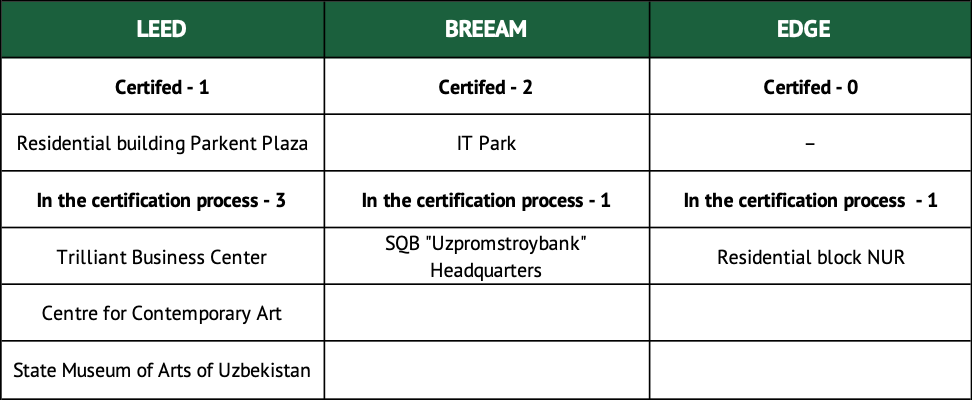
Residential building Parkent Plaza, Tashkent
The Parkent Plaza residential complex received basic LEED certification and became the first certified facility in the country. It includes two seven-story buildings that feature energy-saving windows, noise-suppressing elevators, and an automated control system for all utilities. The solutions in the field of energy-efficient design, reducing water consumption, site selection and construction, using sustainable materials and proper waste handling, as well as improving indoor environmental quality were introduced.
Parkent Plaza reflects the concept of a “smart city”. Its main principle is to create an environment in which the residents can live and work. The project includes green plantings that ensure a high level of health and an underground parking garage that realizes the idea of a “car-free courtyard”. The residential complex is located in an area with smart infrastructure and has a favorable location not far from the city center and near a metro station.
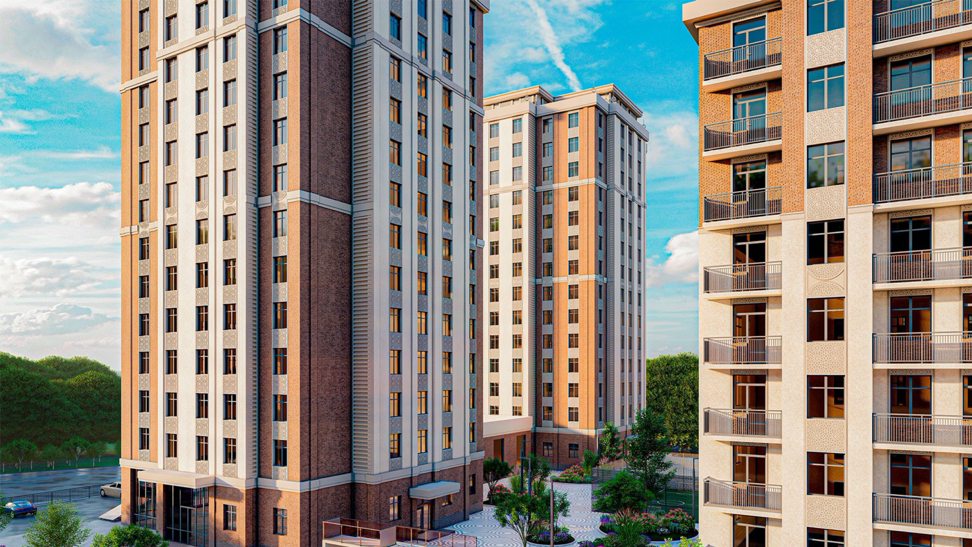
RC Parkent Plaza
Photo: parkent-plaza.uz
Trilliant Business Center, Tashkent
Trilliant, an A+ class business park in the center of Tashkent, is on its way to obtaining LEED Gold certification. The complex, with a total area of 125,000 square meters, features three main towers: two office buildings and a hotel. All three buildings are passing LEED certification.
The business park project was developed by the Singaporean company DP Architects inspired by the history and culture of Uzbekistan. The three business centers are highly efficient structures with constant air circulation. The two office buildings, 14 and 17 stories high, accommodate over 300 office spaces. The second 17-story building is an international five-star InterContinental hotel with a lounge area, spa, and gym.
During construction, solutions were implemented to reduce the carbon footprint, introduce waste processing and management systems, and smart ventilation systems. Other technological solutions include the collection and recycling of waste materials into new materials, eco-friendly landscape design, car charging stations, and reducing energy and water consumption during construction. Green construction allowed to reduce operating costs.

Trilliant Business Center
Photo: www.trillianttashkent.uz
Centre for Contemporary Art, Tashkent
The Center for Contemporary Art in Tashkent is a LEED project with a target Gold level. HPBS experts have been supporting its certification since last year.
The project is an innovative space designed to support the development of contemporary culture in Central Asia. The center is being constructed on the site of a historic building from 1912. Through renovation and transformation, the center will act as a catalyst for the development of Uzbekistan’s art scene. Work on the building’s renovation began in 2022.
The project is in the process of LEED certification. At the moment, HPBS experts have developed a certification strategy that includes improving energy efficiency, water efficiency, and the sustainability of materials. All sections, which are implemented at all stages of the project under the supervision of an accredited expert of the LEED certification system, have been worked through.
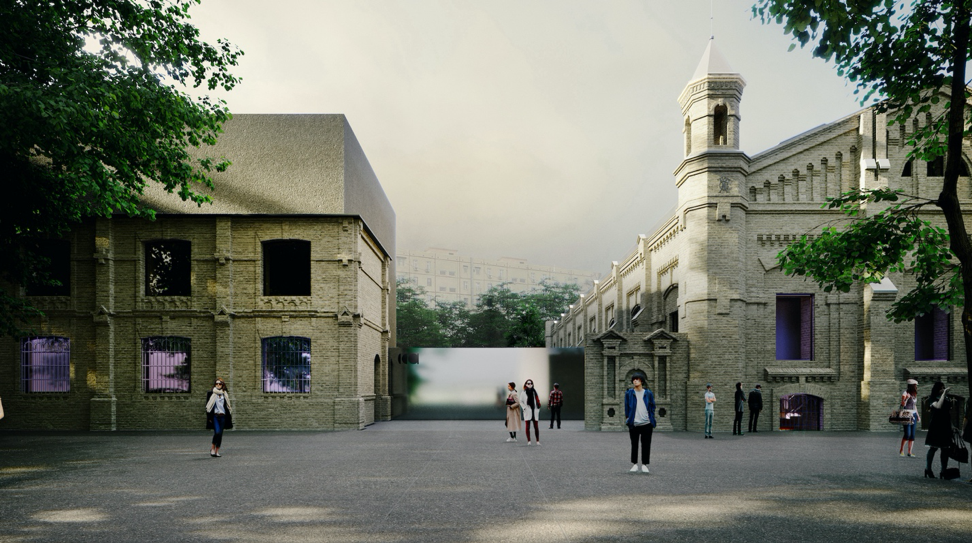
Center for Contemporary Art in Tashkent
Photo: www.ccat.uz
State Museum of Arts of Uzbekistan, Tashkent
The State Art Museum of Uzbekistan is a unique architectural project with a total area of 40,000 sq. m, 30,000 sq. m of which are presented as open space. The museum is located in the historical part of Tashkent, on the territory of the largest national park in Uzbekistan, Alisher Navoi.
The planned building is a nine-story museum complex with three underground levels. The building is composed of three spaces in circular, square, and triangular shapes of varying heights.
The project features a huge exhibition hall, spacious cafes and a restaurant, a library, VIP and conference areas, and a general multifunctional space.
The certification of the museum building is supported by the HPBS team. The client’s goal was to certify the building under the LEED green building certification program with a target level of Silver, however, during the work, our experts identified the project’s potential for the Gold level. Currently, the certification strategy includes increasing energy efficiency, water efficiency, and the sustainability of materials. All sections of the LEED certification system, which are being implemented at all stages of the project under the supervision of an accredited expert, have been developed.
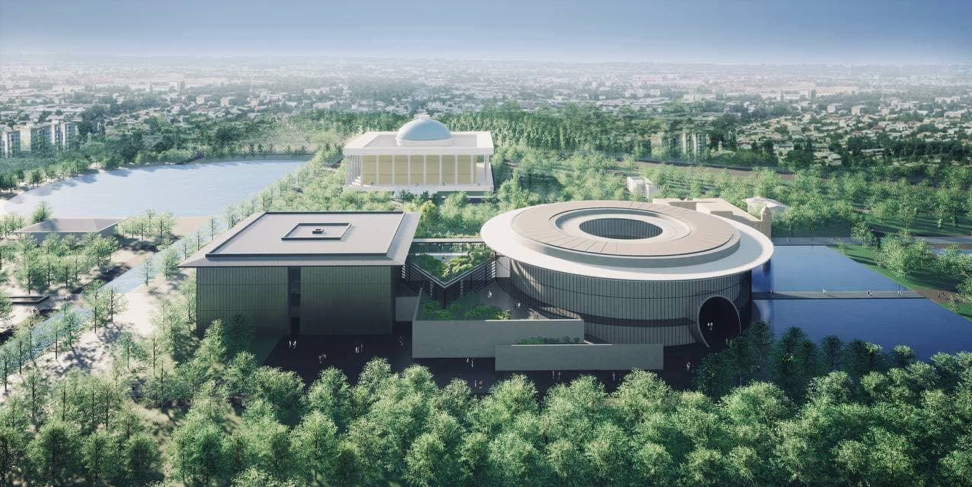
State Museum of Arts of Uzbekistan
Photo: repost.uz
IT Park, Tashkent
IT Park is the first technology park in Uzbekistan. The complex, with a total area of 400,000 sq. m, includes 6 office buildings, a conference hall, a car park, and a bicycle parking area. In 2023, two facilities of the technology cluster underwent BREEAM certification at the Very Good level.
The project used environmentally friendly materials, such as double-glazed windows with low thermal conductivity, which provide efficient insulation. The building is equipped with an energy management system, as well as solar panels on the roof that are used for generating clean energy. Additionally, measures to reduce water consumption used for irrigation and maintenance of protective green plantings have been implemented in the buildings of the complex.
The IT Park opened in 2019. It has already managed to launch around 30 startups, a dozen IT projects, and a number of educational programs. By 2024, there are plans to build an IT Academy, IT University, office complexes, a hotel, a coworking center, sports facilities, and an underground parking lot here. All the facilities will comply with the international environmental standard BREEAM.
.
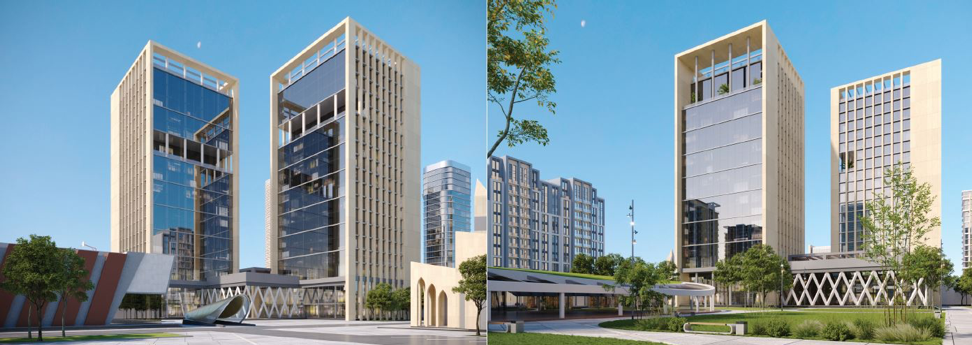
Two office buildings in the IT Park, Tashkent
Photo: www.altensis.com
SQB “Uzpromstroybank” Headquarters, Tashkent
Within the Tashkent City business center, a 33-story building for the headquarters of Uzpromstroybank that incorporates the principles of “Green banking” in its strategy, will be constructed. This means that the bank pays special attention to environmentally responsible investments and financial products that contribute to sustainable development and environmental protection. Thanks to the green banking program, the new Uzpromstroybank building will undergo BREEAM certification.
An eco-friendly solution of the project is the well-thought-out concept of energy efficiency and the use of environmentally friendly materials in construction. Natural lighting will prevail in the building improving the quality of the interior environment. In addition, there will be a system for energy saving, water conservation, and waste disposal. The smart location and access to the use of alternative transportation will also have a positive impact on the overall environmental condition of the area.
The project is being implemented with financial support from a consortium of foreign banks (Citibank, China Eximbank, Raiffeisenbank) led by Credit Suisse. Uzpromstroybank has already signed a credit agreement with partners.
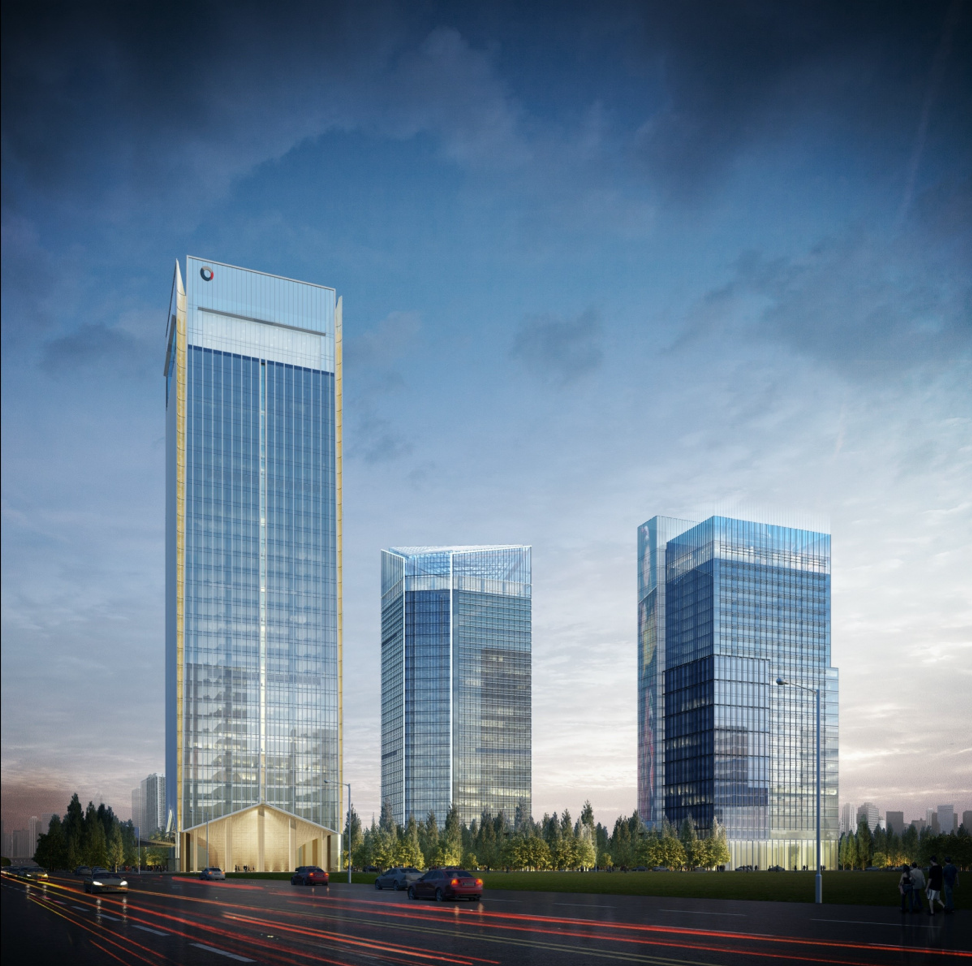
SQB “Uzpromstroybank” Head office, the building on the left
Photo: sqb.uz
EDGE is a standard developed by the International Financial Corporation (IFC), a branch of the World Bank. It is funded by Switzerland and the United Kingdom with the aim of promoting and simplifying the creation of green and sustainable buildings in developing countries, including Uzbekistan, with the possibility of receiving various benefits from international institutions. The standard serves as an accessible tool for CIS countries to obtain green financing from banks.
Residential block NUR, Tashkent
The NUR residential complex (Namuna Development) is the first project in the country to be certified under the EDGE system. HPBS experts are supporting the certification of the buildings and helping to create a comfortable, resource-efficient, and eco-friendly space for future residents.
The new residential complex consists of 30 buildings with 9 and 16 floors, along with extensive surrounding infrastructure. The total area amounts to 3.55 hectares.
NUR Residential Complex is a pilot project of Namuna Development. The neighborhood quarter is a “city within a city,” where residents can find everything they need for a fulfilling lifestyle. It is located in the center of Tashkent. The basis of the ecological concept of the complex is the balance between nature and modern technologies. That’s why half of the courtyard area is allocated for a green zone.
Led by the CEO of HPBS, Ilya Zavaleev, as an EDGE auditor, the HPBS team is providing comprehensive support for the project’s EDGE certification, including:
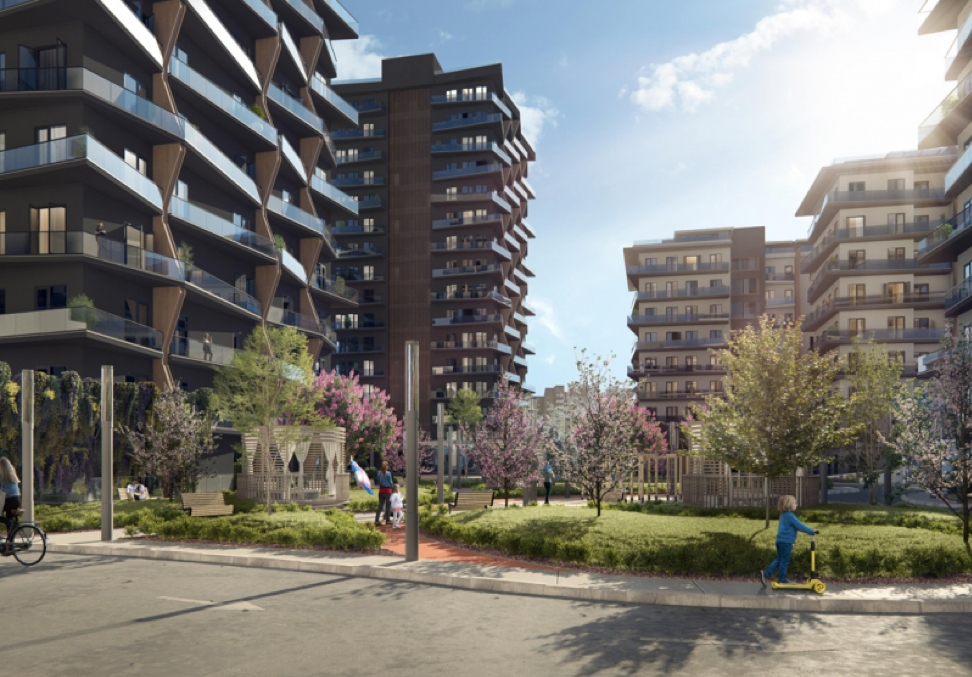
Residential block NUR
Photo: nur.namunadevelopment.uz
It’s worth noting that EDGE is a less complex and demanding certification system compared to LEED or BREEAM. The goal of the standard is to provide accessible tools for building planning and certification. Therefore, it is perfectly suited for those developers who want to apply green technologies in their projects but are not yet ready to implement the more complex certification systems.
The Creating Markets Advisory (CMA), a special group within IFC, is working on establishing market conditions to increase investments in developing countries. CMA has launched a new advisory project to promote green building in Uzbekistan. The project is based on the IFC EDGE Green Building Program (Excellence in Design for Greater Efficiencies). It will be implemented in partnership with the Ministry of Construction and other government entities, as well as with private sector stakeholders in Uzbekistan. The program will support policy reform to promote green building, build capacity, and raise awareness about green building and EDGE certification, work with academia to develop professional skills in green building, and support the increase in the stock of certified green buildings in Uzbekistan.
Green construction entered the market in Uzbekistan relatively recently, along with the first LEED-certified object, the Parkent Plaza residential complex, in 2018. This was facilitated by the Republic’s active work on reforms and programs for the “green” transformation of the economy:
International organizations actively contribute to the development of the “green” agenda in Uzbekistan. Special financing programs for developing countries enable the Republic to implement projects in the field of eco-friendly construction and sustainable development. For example, the European Bank for Reconstruction and Development (EBRD), the Government of Japan, and a consortium of international experts have helped the country to develop the “Roadmap for Transitioning to Low-Carbon Energy.” In 2022, the World Bank provided Uzbekistan with a concessional loan of 143 million dollars for the implementation of the “Clean Energy for Buildings in Uzbekistan” project.
The small number of certified buildings in Uzbekistan is a temporary phenomenon. More and more clients are requesting services for building certification support. The demand for green construction is gaining momentum, thanks to the Republic’s new “green” development strategy, the support of international institutions, and favorable conditions for implementing environmentally friendly projects. Therefore, the business community in Uzbekistan has the potential to implement green construction projects not only in Tashkent but also in other regions of the country.
Learn more:
International Certification of Buildings and Territories